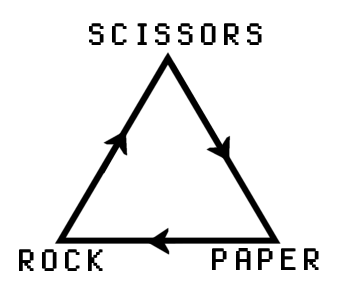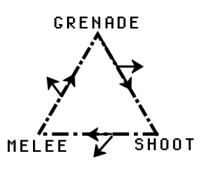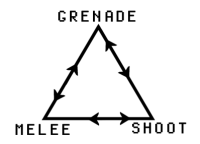Counterpoint: The Depth of Interplay pt.4
 Wednesday, April 22, 2009 at 3:17PM
Wednesday, April 22, 2009 at 3:17PM Previously I covered closed loops of interplay and how they can add a lot of depth to a game system without adding a lot of complexity. Other than Rock Paper Scissors, there are other examples of interplay loops that are worth mentioning as well as a few different types of loops.
Unidirectional Flow & Strict Encounters
 The flow of interplay for RPS only moves in one direction. When you throw the same hand, there is neither a winner or a loser, and both players must throw again. This "tie breaker" design works to balance out the relationship between the three options (Rock-Paper-Scissors/Win-Lose-Draw). To counter a hand in RPS, you must throw the single option that beats your opponent. This triangle interplay system is unidirectional with very strict encounters with very little variation. In other words, you can't throw half a rock and half paper. You must throw one of the 3 options and the results will be one of 3 distinct possibilities.
The flow of interplay for RPS only moves in one direction. When you throw the same hand, there is neither a winner or a loser, and both players must throw again. This "tie breaker" design works to balance out the relationship between the three options (Rock-Paper-Scissors/Win-Lose-Draw). To counter a hand in RPS, you must throw the single option that beats your opponent. This triangle interplay system is unidirectional with very strict encounters with very little variation. In other words, you can't throw half a rock and half paper. You must throw one of the 3 options and the results will be one of 3 distinct possibilities.
Dynamic Encounters
 In Halo 3, a much looser triangle exist between the SHOOT, MELEE, and GRENADE mechanics. To simply, SHOOTing while backing up is a counter to the opponent trying to close in and MELEE attack. MELEEing a player counters their attempt to throw a frag grenade at you because the lunge helps close in the distance between the two players and the grenade will land somewhere behind you. And finally, the GRENADE can be thrown preemptively to damage a target just as they come into view or even when they are out of any direct line of sight. Since the weapons in Halo don't fire from around corners or cover, when a target is out of direct sight, they are unable to SHOOT back at you. In this way, the GRENADE mechanic counters the SHOOT mechanic.
In Halo 3, a much looser triangle exist between the SHOOT, MELEE, and GRENADE mechanics. To simply, SHOOTing while backing up is a counter to the opponent trying to close in and MELEE attack. MELEEing a player counters their attempt to throw a frag grenade at you because the lunge helps close in the distance between the two players and the grenade will land somewhere behind you. And finally, the GRENADE can be thrown preemptively to damage a target just as they come into view or even when they are out of any direct line of sight. Since the weapons in Halo don't fire from around corners or cover, when a target is out of direct sight, they are unable to SHOOT back at you. In this way, the GRENADE mechanic counters the SHOOT mechanic.
The scenarios described above are a simplification of a player v. player encounter in Halo 3. In an actual match, the dynamics of space (distances, terrain, relative elevation) and time (movement speeds, grenade arc times, bullet travel time) significantly change the comparative advantages in a given encounter. This is not even mentioning powerups like the overshield or the different weapons a player can pick up that can increase their shooting, melee, and grenade abilities. Also, most player v. player encounters result in both players taking damage. The results of encounters aren't clear cut and pure like in RPS where you'll either win or lose completely. Sometimes, taking damage to get a kill can result in an overall loss depending on the overall game that's being played. For these reasons, the interplay and the results of encounters in Halo are more dynamic than in a game like RPS.
Mini Loops
 In RPS, if a Rock is thrown against a Rock both players get a "redo" with no penalties (wins or losses) given for throwing the same hand. This is just one reason why RPS is such a simple game to understand. But for any game with mechanics more dynamic than the hands in RPS, perfect ties that result in a "redo" are rare. If two players SHOOT at each other in Halo, they're not locked in a stalemate and forced to try again. They're actually working toward a kill by reducing the other player's shield energy or health in real time. Assume neither player runs away from this player v. player encounter, the player with the better aim, dodging, and/or weapon will win. It's the same with the GRENADE and MELEE mechanics. In fact, it's not uncommon for two players to kill each other with two simultaneous melee/grenade attacks. Is this a lose-lose, win-win, or a tie? It's hard to say.
In RPS, if a Rock is thrown against a Rock both players get a "redo" with no penalties (wins or losses) given for throwing the same hand. This is just one reason why RPS is such a simple game to understand. But for any game with mechanics more dynamic than the hands in RPS, perfect ties that result in a "redo" are rare. If two players SHOOT at each other in Halo, they're not locked in a stalemate and forced to try again. They're actually working toward a kill by reducing the other player's shield energy or health in real time. Assume neither player runs away from this player v. player encounter, the player with the better aim, dodging, and/or weapon will win. It's the same with the GRENADE and MELEE mechanics. In fact, it's not uncommon for two players to kill each other with two simultaneous melee/grenade attacks. Is this a lose-lose, win-win, or a tie? It's hard to say.
Within a single point of the interplay triangle (SHOOT, MELEE, GRENADE) smaller loops of interplay can exist. My favorite example from Halo 3 is the intricate "dance" of Plasma Sword combat. The Plasma Sword is a weapon that gives the players incredible melee abilities. By getting reasonably close to a target, players can lunge very quickly for a long range strike in a big flashy animation. Intead of lunging, you can use the quicker swing that has a much smaller range. These two options are balanced against each other according their speed (attack start up time and cool down time) and distance (range). When fighting sword v. sword, if both player use either of these attacks against each other at about the same time, the swords clash in a Star Wars-esk flash of light. When this happens both players lose a bit of shield energy. Though the clash prevents either player from dying (even when their shields are completely drained) the cool down animations of each sword attack remain the same. This design creates a very RPS like relationship between the sword moves. Clashing a short sword attack against a lunge attack allows you to do another short sword attack before the opponent can recover from the flashy lunge animation. If the opponent jumps and lunges or waits for you to use a short sword attack as a counter, the lunge can be perfectly timed to defeat you. Mixing up these options can create quite a dance to the death. And that's just one example of a mini interplay loop that can exist on one point of a larger interplay relationship.
Reverse Flow
 Depending on the type of weapon used and other factors (timing, positioning, terrain), the flow of interplay between SHOOT, MELEE, and GRENADE can be completely reversed. For example, the powerful shotgun is able to take out opponents in one shot. A Player with a shotgun can beat a MELEEing opponent even if the opponent gets the first hit. But if you melee an opponent in the back, in most situations they'll die in one hit no matter what weapon they have. A well thrown Plasma grenade can take out an opponent with serious firepower or meleeing abilities. For example, sticking a Plasma grenade to an opponent with the sword or the hammer can be a great way to survive the encounter in a tight situation. Using the Plasma Sword's sword lunge attack can overcome an opponent backing up with almost any firearm.
Depending on the type of weapon used and other factors (timing, positioning, terrain), the flow of interplay between SHOOT, MELEE, and GRENADE can be completely reversed. For example, the powerful shotgun is able to take out opponents in one shot. A Player with a shotgun can beat a MELEEing opponent even if the opponent gets the first hit. But if you melee an opponent in the back, in most situations they'll die in one hit no matter what weapon they have. A well thrown Plasma grenade can take out an opponent with serious firepower or meleeing abilities. For example, sticking a Plasma grenade to an opponent with the sword or the hammer can be a great way to survive the encounter in a tight situation. Using the Plasma Sword's sword lunge attack can overcome an opponent backing up with almost any firearm.
It's important to note here that in Halo 3 and many other games (Street Fighter 4, Super Smash Brothers Brawl), executing a move or maneuver that reverses the flow of interplay is generally much more difficult taking significantly more skill to pull off than going with the natural flow of interplay. In this way, you won't see the flow reversed nearly as often as you see it flowing normally. This design helps keep everything working smoothly with counters that work most of the time.
Multi Loops
 The Fire Emblem games feature many different interplay triangles of attack effectiveness. Swords are strong against Axes and weak against Lances. Flying units are weak against archer units, which are weak against melee attacking units. Light magic is powerful against Dark magic but weak against Anima magic. Because there are so many different interplay triangles in the core combat system, a single character can represent points or even parts of several triangles at once. For example, the Pegasis unit is a flying unit that is able to carry and use a sword and a lance. Some magic users can use dark magic and anima magic.
The Fire Emblem games feature many different interplay triangles of attack effectiveness. Swords are strong against Axes and weak against Lances. Flying units are weak against archer units, which are weak against melee attacking units. Light magic is powerful against Dark magic but weak against Anima magic. Because there are so many different interplay triangles in the core combat system, a single character can represent points or even parts of several triangles at once. For example, the Pegasis unit is a flying unit that is able to carry and use a sword and a lance. Some magic users can use dark magic and anima magic.
Some Loops Aren't Loops
Water douses fire. Fire burns Grass. And Grass is nourished by Water. This is the basic interplay relationship between the 3 starting Pokemon in just about every handheld Pokemon RPG adventure. Unfortunately, this is only the tip of the complexity iceberg for Pokemon. In this game, there aren't just 3 types of Pokemon. There are 17. And to make things even more complicated, each Pokemon can exhibit properties of at most 2 of these 17 types. If the interrelationship between these 17 types were arranged in a shape, it would be a hideous, asymmetrical, blob of a thing with lines that crisscross inside of it. Or perhaps something like this? David Sirlin does a good job of explaining the basic of combat and the game design lunacy of having 17 types here.
In the next of this series, I'll go over a few more specifics on interplay and how larger strategies are created from manipulating the potential for interplay.

